Global Mean Sea Level Variation on Interannual–Decadal Timescales: Climatic Connections
Abstract
1. Introduction
2. Data: Preparation and Methodology
3. Results: GMSL–Climate Correlations
4. Discussion and Conclusions
Author Contributions
Funding
Institutional Review Board Statement
Data Availability Statement
Acknowledgments
Conflicts of Interest
Abbreviations
| GMSL | Global Mean Sea Level |
| GMSL-ID | Interannual–Decadal Variation of GMSL |
| ENSO | El Niño-Southern Oscillation |
| ENSO-CP | Central Pacific ENSO |
| ENSO-EP | Eastern Pacific ENSO |
| PDO | Pacific Decadal Oscillation |
| AMO | Atlantic Multidecadal Oscillation |
| AO | Arctic Oscillation |
| AAO | Antarctic Oscillation |
References
- Cazenave, A.; Dieng, H.B.; Meyssignac, B.; Von Schuckmann, K.; Decharme, B.; Berthier, E. The rate of sea-level rise. Nat. Clim. Chang. 2014, 4, 358–361. [Google Scholar] [CrossRef]
- Cazenave, A. The WCRP Global Sea Level Budget Group Global sea-level budget 1993–present. Earth Syst. Sci. Data 2018, 10, 1551–1590. [Google Scholar] [CrossRef]
- Frederikse, T.; Landerer, F.; Caron, L.; Adhikari, S.; Parkes, D.; Humphrey, V.W.; Dangedorf, S.; Hogarth, P.; Zanna, L.; Cheng, L.; et al. The causes of sea-level rise since 1900. Nature 2020, 584, 393–397. [Google Scholar] [CrossRef] [PubMed]
- Chen, J.L.; Wilson, C.R.; Tapley, B.D.; Famiglietti, J.S.; Rodell, M. Seasonal global mean sea level change from satellite altimeter, GRACE, and geophysical models. J. Geod. 2005, 79, 532–539. [Google Scholar] [CrossRef]
- Vinogradov, S.V.; Ponte, R.M.; Heimbach, P.; Wunsch, C. The mean seasonal cycle in sea level estimated from a data-constrained general circulation model. J. Geophys. Res. 2008, 113, C03032. [Google Scholar] [CrossRef]
- García-García, D.; Vigo, I.; Trottini, M. Water transport among the world ocean basins within the water cycle. Earth Syst. Dynam. 2020, 11, 1089–1106. [Google Scholar] [CrossRef]
- Cazenave, A.; Remy, F. Sea level and climate: Measurements and causes of changes. Wiley Interdiscip. Rev.-Clim. Chang. 2011, 2, 647–662. [Google Scholar] [CrossRef]
- Chambers, D.P.; Mehlhaff, C.A.; Urban, T.J.; Fujii, D.; Nerem, R.S. Low-frequency variations in global mean sea level: 1950–2000. J. Geophys. Res. Ocean. 2002, 107, 3026. [Google Scholar] [CrossRef]
- Willis, J.K.; Chambers, D.P.; Nerem, R.S. Assessing the globally averaged sea level budget on seasonal to interannual timescales. J. Geophys. Res. Ocean. 2008, 113, C06015. [Google Scholar] [CrossRef]
- Boening, C.; Willis, J.K.; Landerer, F.W.; Nerem, R.S.; Fasullo, J. The 2011 La Niña: So strong, the oceans fell. Geophys. Res. Lett. 2012, 39, 19. [Google Scholar] [CrossRef]
- Cazenave, A.; Henry, O.; Munier, S.; Delcroix, T.; Gordon, A.L.; Meyssignac, B.; Llovel, W.; Palanisamy, H.; Becker, N. Estimating ENSO Influence on the Global Mean Sea Level 1993–2010. Mar. Geod. 2012, 35, 82–97. [Google Scholar] [CrossRef]
- Haddad, M.; Taibi, H.; Arezki, S.M.M. On the recent global mean sea level changes: Trend extraction and El Nino’s impact. Comptes Rendus Geosci. 2013, 345, 167–175. [Google Scholar] [CrossRef]
- Jin, T.Y.; Li, J.C.; Jiang, W.P.; Chu, Y.H. Low-frequency sea level variation and its correlation with climate events in the Pacific. Chin. Sci. Bull. 2012, 57, 3623–3630. [Google Scholar] [CrossRef][Green Version]
- Zhang, X.B.; Church, J.A. Sea level trends, interannual and decadal variability in the Pacific Ocean. Geophys. Res. Lett. 2012, 39, L21701. [Google Scholar] [CrossRef]
- Hamlington, B.D.; Leben, R.R.; Strassburg, M.W.; Nerem, R.S.; Kim, K. Contribution of the Pacific Decadal Oscillation to global mean sea level trends. Geophys. Res. Lett. 2013, 40, 5171–5175. [Google Scholar] [CrossRef]
- Hamlington, B.D.; Reager, J.T.; Lo, M.; Karnauskas, K.B.; Leben, R.R. Separating decadal global water cycle variability from sea level rise. Sci. Rep. 2017, 7, 995. [Google Scholar] [CrossRef]
- Kuo, Y.N.; Lo, M.H.; Liang, Y.C.; Tseng, Y.H.; Hsu, C.W. Terrestrial Water Storage Anomalies emphasize interannual variations in global mean sea level during 1997–1998 and 2015–2016 El Niño events. Geophys. Res. Lett. 2021, 48, e2021GL094104. [Google Scholar] [CrossRef]
- Wahl, T.; Chambers, D.P. Climate controls multidecadal variability in US extreme sea level records. J. Geophys. Res.-Ocean. 2016, 121, 1274–1290. [Google Scholar] [CrossRef]
- Rohmer, J.; Cozannet, L.G. Dominance of the mean sea level in the high-percentile sea levels time evolution with respect to large-scale climate variability: A Bayesian statistical approach. Environ. Res. Lett. 2019, 14, 014008. [Google Scholar] [CrossRef]
- Moreira, L.; Cazenave, A.; Palanisamy, H. Influence of interannual variability in estimating the rate and acceleration of present-day global mean sea level. Glob. Planet. Chang. 2021, 199, 103450. [Google Scholar] [CrossRef]
- Chao, B.F.; Yu, Y.; Chung, C.H. Variation of Earth’s Oblateness J2 on Interannual-to-Decadal Timescales. J. Geophys. Res. Lett. 2020, 125, e2020JB019421. [Google Scholar] [CrossRef]
- Kao, H.Y.; Yu, J.Y. Contrasting Eastern-Pacific and Central-Pacific Types of ENSO. J. Clim. 2009, 22, 615–632. [Google Scholar] [CrossRef]
- Wallace, J.M.; Gutzler, D.S. Teleconnections in the geopotential height field during the northern hemisphere winter. Mon. Weather Rev. 1981, 109, 784–812. [Google Scholar] [CrossRef]
- Thompson, D.W.J.; Wallace, J.M. Annular Modes in the Extratropical Circulation. Part I: Month-to-Month Variability. J. Clim. 2000, 13, 1000–1016. [Google Scholar] [CrossRef]
- Newman, M.; Alexander, M.; Ault, T.R.; Cobb, K.M.; Deser, C.; Di Lorenzo, E.; Mantua, N.J.; Miller, A.J.; Minobe, S.; Nakamura, H.; et al. The Pacific decadal oscillation, revisited. J. Clim. 2016, 29, 4399–4427. [Google Scholar] [CrossRef]
- Chen, X.; Wallace, J.M. Orthogonal PDO and ENSO Indices. J. Clim. 2016, 29, 3883–3892. [Google Scholar] [CrossRef]
- Chao, B.F.; Chung, C.H. On Estimating the Cross-Correlation and Least-squares Fit of One Dataset to Another with Time Shift. Earth Space Sci. 2019, 6, 1409–1415. [Google Scholar] [CrossRef]
- Chao, B.F.; Eanes, R.J. Global gravitational change due to atmospheric mass redistribution as observed by the Lageos’ nodal residual. Geophys. J. Int. 1995, 122, 755–764. [Google Scholar] [CrossRef]
- Thomson, D.J. Thomson Spectrum estimation and harmonic analysis. Proc. IEEE 1982, 70, 1055–1096. [Google Scholar] [CrossRef]
- Wu, S.; Liu, Z.; Zhang, R.; Delworth, T.L. On the observed relationship between the Pacific Decadal Oscillation and the Atlantic Multi-decadal Oscillation. J. Ocean. 2011, 67, 27–35. [Google Scholar] [CrossRef]
- Prandi, P.; Ablain, M.; Cazenave, A.; Picot, N. A New Estimation of Mean Sea Level in the Arctic Ocean from Satellite Altimetry. Mar. Geod. 2012, 35, 61–81. [Google Scholar] [CrossRef]
- Cheng, Y.C.; Andersen, O.; Knudsen, P. An Improved 20-Year Arctic Ocean Altimetric Sea Level Data Record. Mar. Geod. 2015, 38, 146–162. [Google Scholar] [CrossRef]
- Chao, B.F.; Wu, Y.H.; Li, Y.S. Impact of artificial reservoir water impoundment on global sea level. Science 2008, 320, 212–214. [Google Scholar] [CrossRef] [PubMed]
- Wada, Y.; van Beek, L.P.H.; Weiland, F.C.S.; Chao, B.F.; Wu, Y.H.; Bierkens, M.F.P. Past and future contribution of global groundwater depletion to sea-level rise. Geophys. Res. Lett. 2012, 39, L09402. [Google Scholar] [CrossRef]
- Yi, S.; Heki, K.; Qian, A. Acceleration in the Global Mean Sea Level Rise: 2005–2015. Geophys. Res. Lett. 2017, 44, 11905–11913. [Google Scholar] [CrossRef]
- Llovel, W.; Becker, M.; Cazenave, A.; Cretaux, J.F.; Ramillien, G. Global land water storage change from GRACE over 2002–2009; Inference on sea level. Comptes Rendus Geosci. 2010, 342, 179–188. [Google Scholar] [CrossRef]
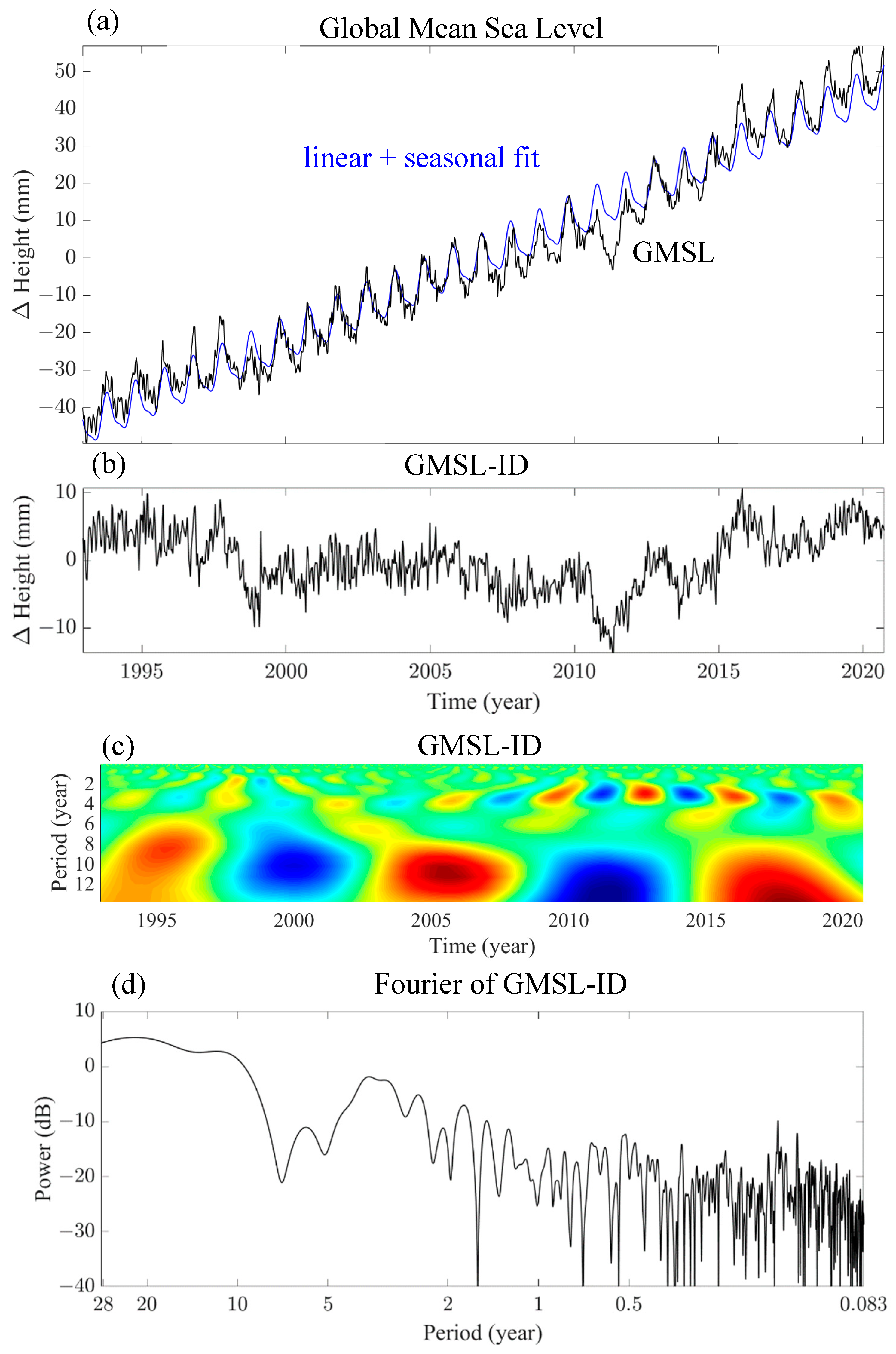
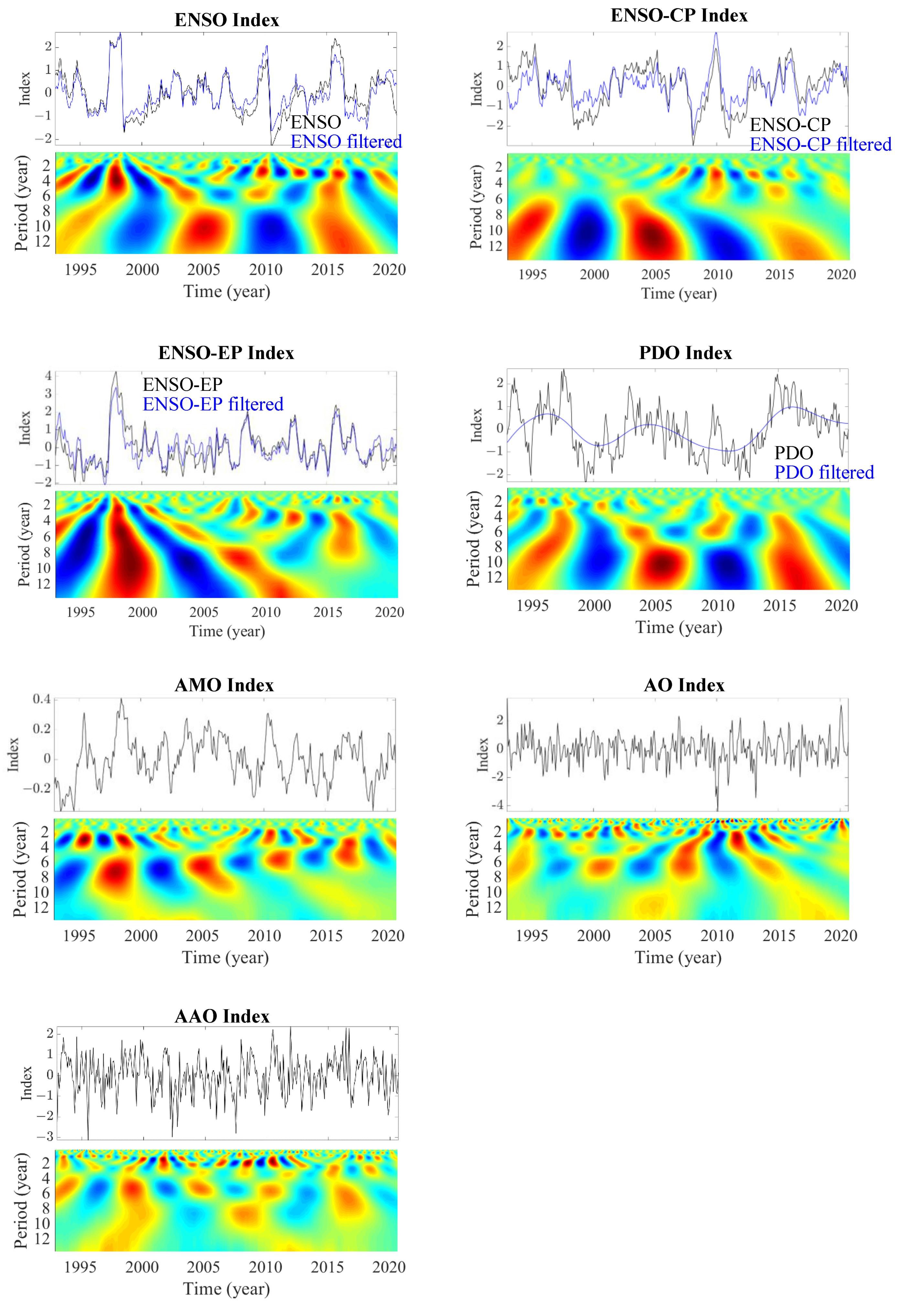
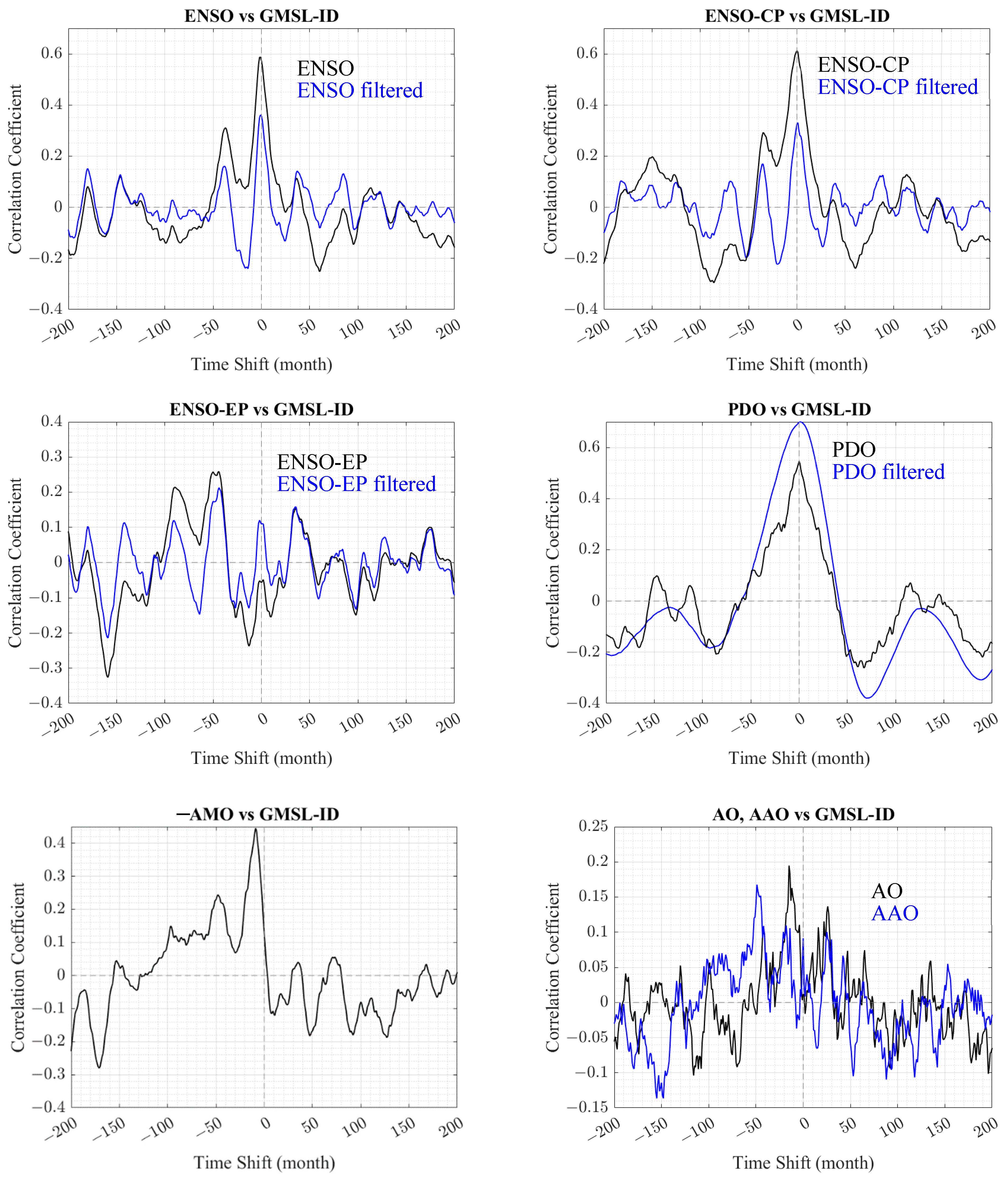
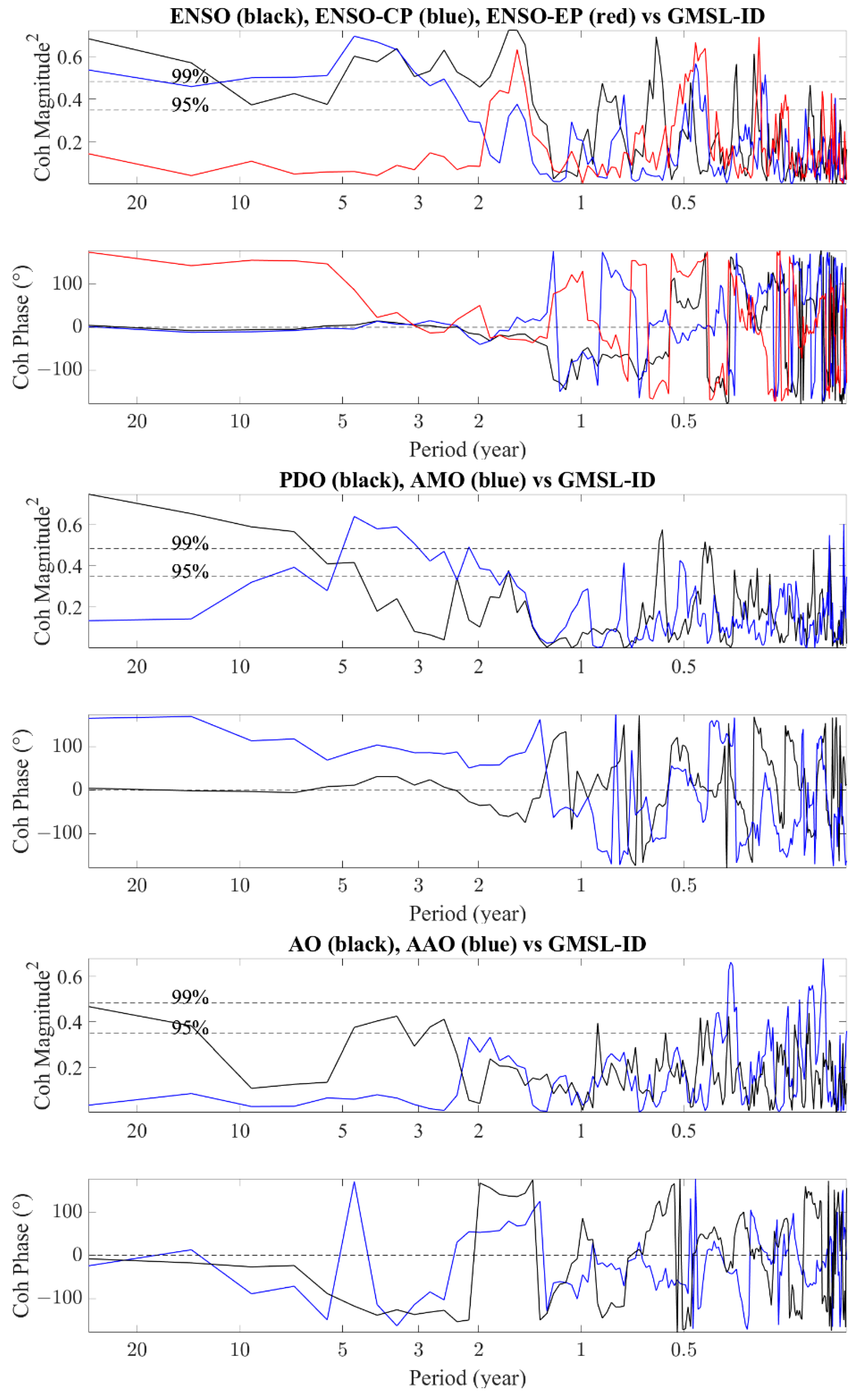
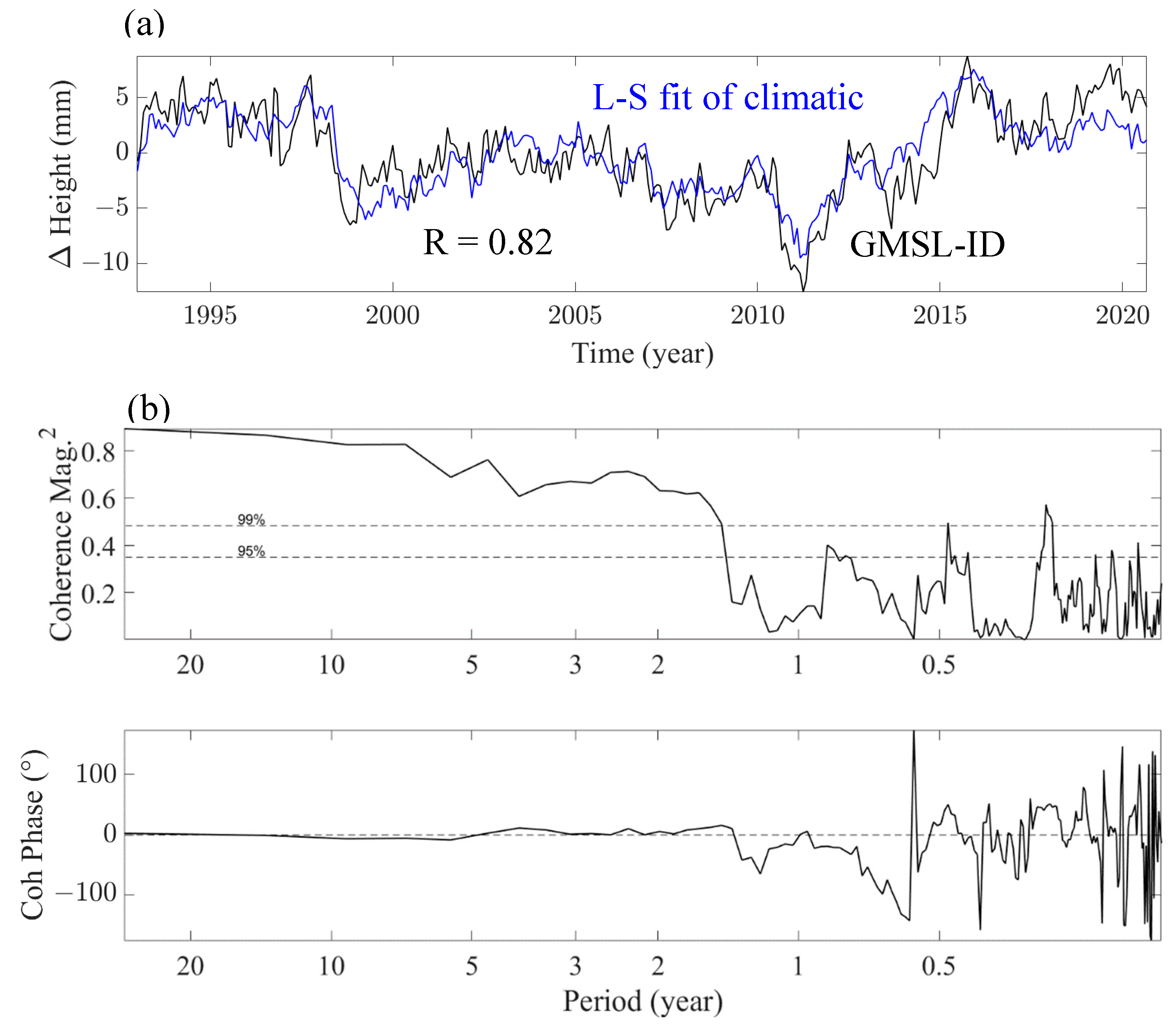
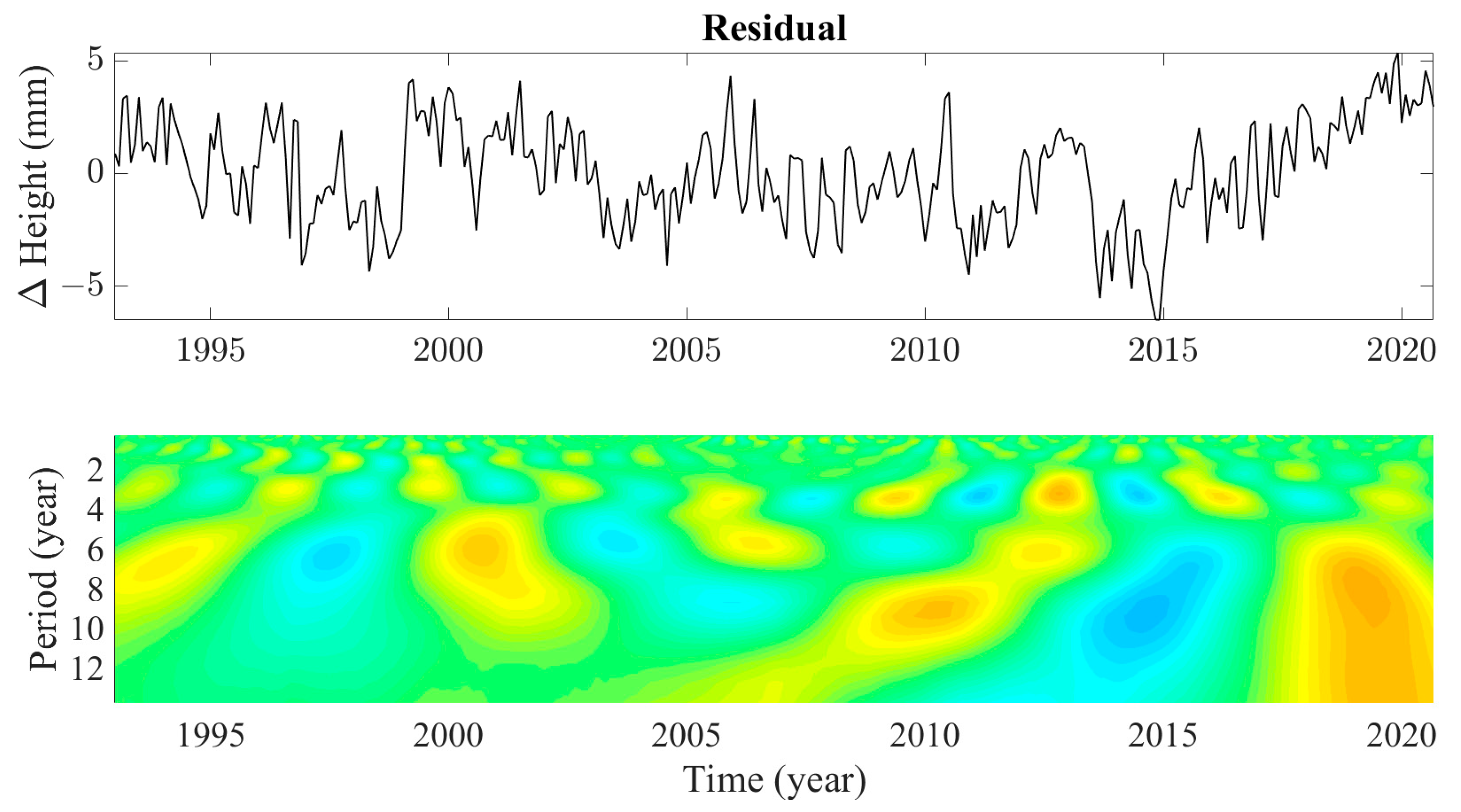
Publisher’s Note: MDPI stays neutral with regard to jurisdictional claims in published maps and institutional affiliations. |
© 2022 by the authors. Licensee MDPI, Basel, Switzerland. This article is an open access article distributed under the terms and conditions of the Creative Commons Attribution (CC BY) license (https://creativecommons.org/licenses/by/4.0/).
Share and Cite
Liao, T.-J.; Chao, B.F. Global Mean Sea Level Variation on Interannual–Decadal Timescales: Climatic Connections. Remote Sens. 2022, 14, 2159. https://doi.org/10.3390/rs14092159
Liao T-J, Chao BF. Global Mean Sea Level Variation on Interannual–Decadal Timescales: Climatic Connections. Remote Sensing. 2022; 14(9):2159. https://doi.org/10.3390/rs14092159
Chicago/Turabian StyleLiao, Ting-Juan, and Benjamin F. Chao. 2022. "Global Mean Sea Level Variation on Interannual–Decadal Timescales: Climatic Connections" Remote Sensing 14, no. 9: 2159. https://doi.org/10.3390/rs14092159
APA StyleLiao, T.-J., & Chao, B. F. (2022). Global Mean Sea Level Variation on Interannual–Decadal Timescales: Climatic Connections. Remote Sensing, 14(9), 2159. https://doi.org/10.3390/rs14092159





